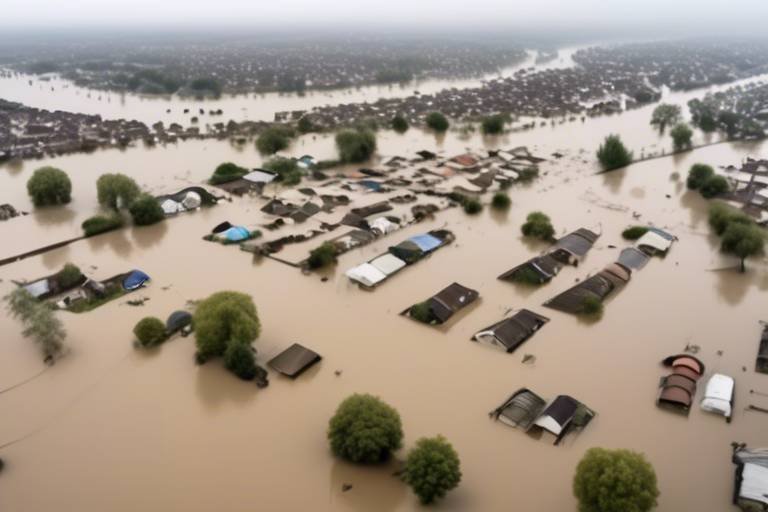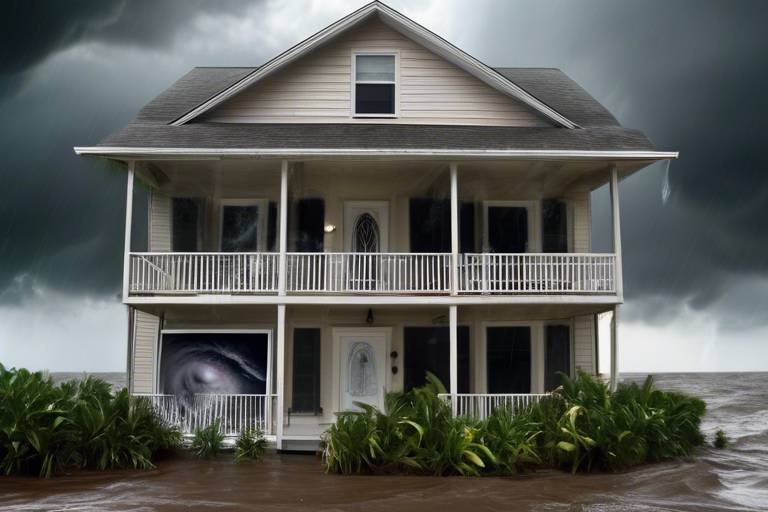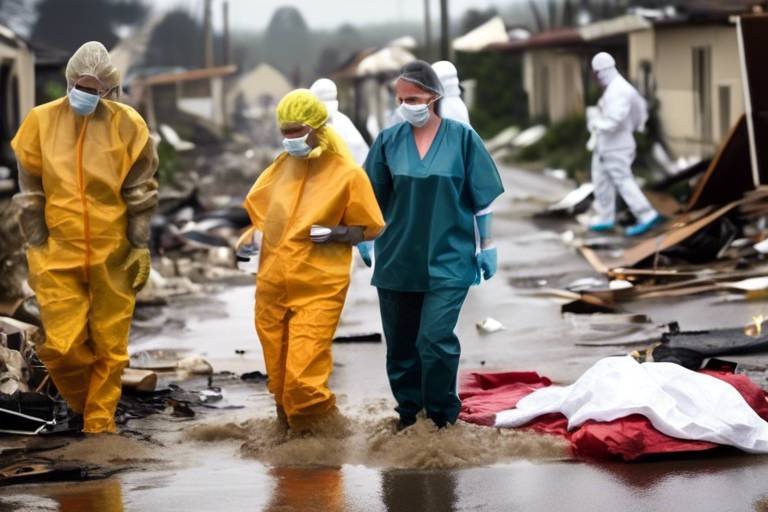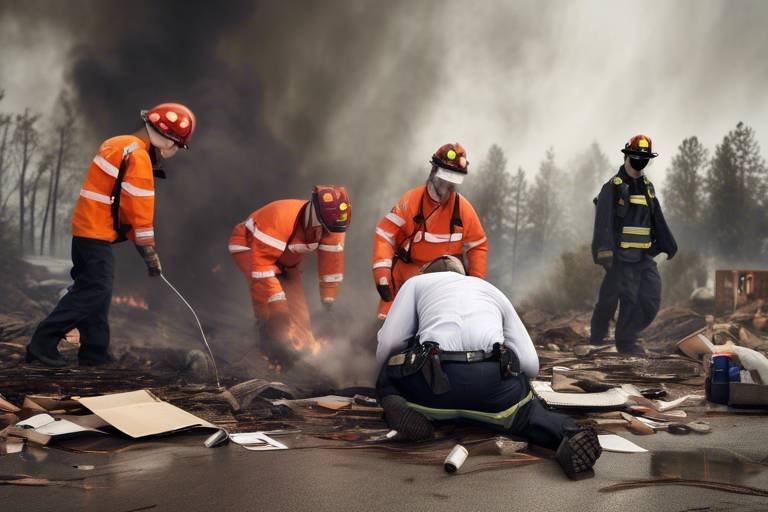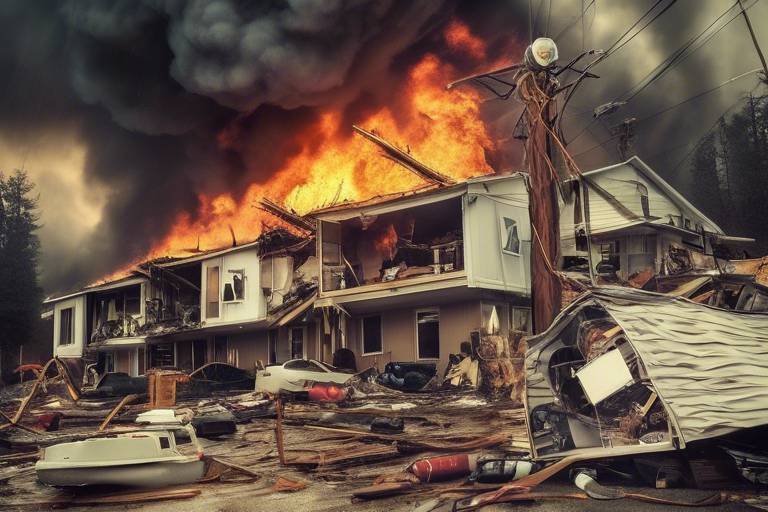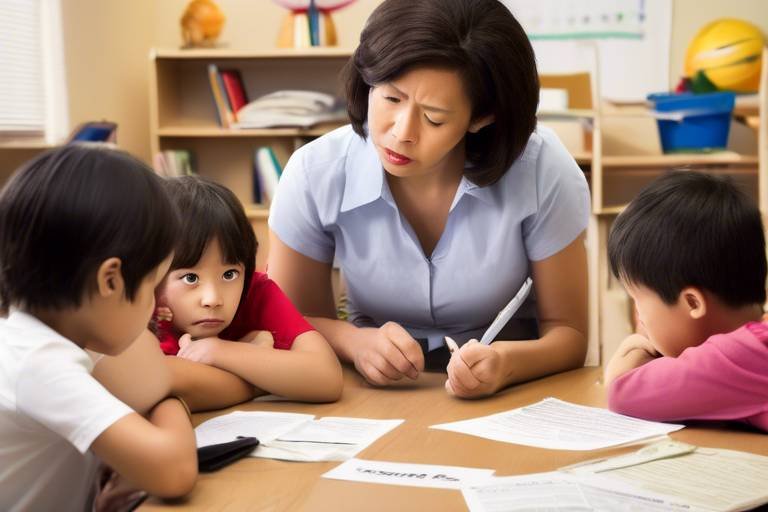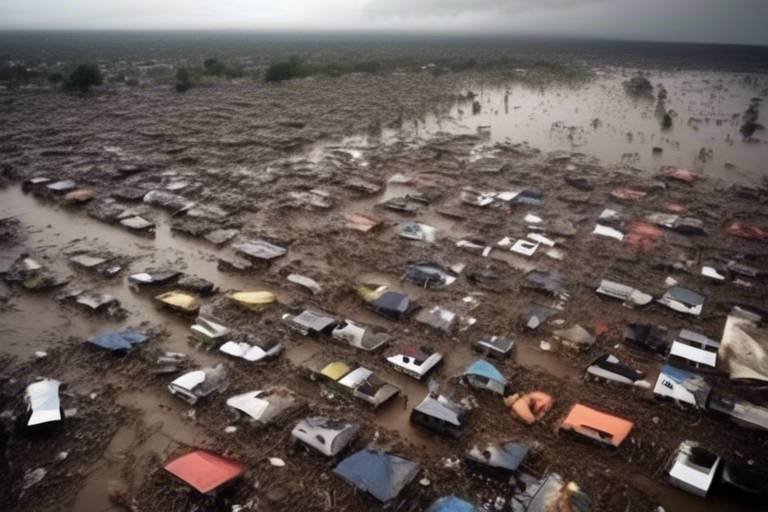How Prepared is Your City for Emergencies?
In today's unpredictable world, the question isn't just whether disasters will strike, but how prepared your city is to handle them. From natural calamities like hurricanes and earthquakes to man-made crises such as industrial accidents, the resilience of urban areas is put to the test. It's not enough for cities to merely have emergency plans tucked away in a drawer; they need to be living, breathing strategies that involve every segment of the community. So, what does it mean for a city to be prepared? Let's dive deeper into the various facets of urban preparedness, including infrastructure, community involvement, and emergency response strategies.
First and foremost, the foundation of any city's emergency preparedness lies in its infrastructure resilience. Think of your city as a complex machine, where every part needs to function smoothly, especially during a crisis. Roads, bridges, and utilities must be robust enough to withstand disasters. For instance, during a flood, the drainage systems should efficiently manage excess water, preventing widespread damage. Cities can assess their infrastructure by conducting regular audits and stress tests, evaluating how well these physical structures can endure extreme conditions. The goal is to ensure that, when disaster strikes, the city can still operate and provide essential services.
But infrastructure alone won't save the day; community engagement is equally vital. Imagine a well-oiled machine that has no one at the controls—it simply won't work. When residents are involved in preparedness initiatives, they become the first responders in their neighborhoods. Engaging the community through training and awareness programs can significantly enhance collective resilience. For example, consider the impact of local workshops that teach residents how to respond in emergencies. This knowledge empowers individuals, transforming them from passive observers into active participants in their safety.
Implementing educational programs is a fantastic way to equip residents with the necessary skills and knowledge. These programs help residents understand emergency procedures and the resources available to them. By fostering a culture of preparedness, cities can ensure that when the time comes, people know exactly what to do. Imagine a community where everyone knows the nearest evacuation routes, the location of emergency shelters, and how to administer basic first aid. This level of preparedness can be the difference between chaos and calm during a crisis.
Regular workshops and drills are essential in building familiarity with emergency protocols. These hands-on experiences prepare citizens for real-life scenarios, making them more likely to react calmly and effectively when an actual emergency occurs. Picture this: a fire drill at your local school or community center. Everyone knows their role, and the practice instills a sense of confidence. When emergencies happen, that confidence translates into action, ultimately saving lives.
Creating volunteer opportunities is another way to foster a sense of responsibility and community spirit. When citizens contribute to local emergency preparedness efforts, they not only gain valuable experience but also strengthen community bonds. Whether it’s helping organize community drills or serving as local coordinators during an emergency, volunteers play a crucial role. This engagement builds a network of support that can be relied upon in times of need.
Establishing effective communication systems is vital for ensuring timely dissemination of information during emergencies. Clear channels can save lives and reduce panic. Imagine a scenario where a natural disaster is imminent. If residents receive accurate and timely information about evacuation routes or safety protocols, they can act swiftly, thereby minimizing risks. Cities should invest in modern communication technologies and ensure that information reaches all demographics, including those with disabilities or language barriers.
A comprehensive emergency response plan is essential for cities. This plan outlines roles, resources, and strategies to manage crises effectively and efficiently. It’s like having a roadmap during a road trip; without it, you might get lost when you need to navigate through uncharted territories. A well-structured plan ensures that everyone knows their responsibilities and can act promptly when emergencies arise.
Collaboration between local agencies enhances response efforts. Regular meetings and joint exercises ensure all parties are prepared to work together during emergencies. Think of it as a symphony orchestra; each musician must know their part to create a harmonious performance. When agencies coordinate effectively, they can leverage their strengths and resources, ensuring a more robust response to any crisis.
Proper allocation and management of resources, including personnel and equipment, are vital for effective emergency response. This ensures that help reaches those in need promptly. Imagine a scenario where a city has a well-stocked emergency shelter, but no trained personnel to manage it. That’s a missed opportunity. Cities must prioritize training and resource distribution to ensure they can respond to emergencies swiftly and efficiently.
Finally, analyzing previous emergency responses provides valuable insights into strengths and weaknesses. Learning from past experiences informs future preparedness strategies. Just like a sports team reviews game footage to improve performance, cities should assess their emergency responses to identify what worked and what didn’t. This continuous improvement cycle is crucial for building a resilient urban environment.
- What should I do to prepare my family for emergencies? Start by creating an emergency plan that includes communication strategies, evacuation routes, and a kit with essential supplies.
- How can I get involved in my community's emergency preparedness efforts? Look for local workshops, volunteer opportunities, and community meetings focused on emergency preparedness.
- What role does local government play in emergency preparedness? Local governments are responsible for creating emergency plans, coordinating resources, and ensuring community engagement.

Assessing Infrastructure Resilience
When it comes to the safety of a city, infrastructure resilience plays a pivotal role. Imagine a city as a living organism; its infrastructure—roads, bridges, utilities, and buildings—are its veins and arteries. If these components are weak or compromised, the entire system can falter, especially during emergencies. Evaluating the robustness of these structures is not just a bureaucratic exercise; it's a matter of life and death. For instance, after natural disasters like hurricanes or earthquakes, cities with resilient infrastructures can bounce back more quickly, while others may struggle for years.
To assess infrastructure resilience effectively, we need to look at several key factors. First, the quality of construction is essential. Are buildings designed to withstand earthquakes? Are bridges built to handle heavy loads? A thorough examination of construction practices and adherence to safety codes can reveal vulnerabilities. Next, we must consider the age of infrastructure. Older structures may not meet current safety standards, making them more susceptible to failure during crises. Regular inspections and updates are crucial to ensure that these aging systems can withstand the test of time.
Moreover, redundancy is a critical aspect of infrastructure resilience. Think of it as having a backup plan. For example, if one power line goes down, having alternative routes for electricity can prevent widespread blackouts. Cities should invest in multiple systems or pathways to ensure that if one fails, others can step in to fill the gap. This kind of planning not only enhances safety but also builds public confidence in the city's ability to handle emergencies.
| Infrastructure Element | Resilience Factors | Importance |
|---|---|---|
| Roads | Durability, Maintenance | Ensure evacuation routes are clear |
| Bridges | Load capacity, Regular inspections | Critical for transportation and logistics |
| Utilities | Backup systems, Redundancy | Maintain essential services like water and electricity |
| Buildings | Earthquake-resistant designs | Protect lives and property during disasters |
In addition to physical structures, we must also evaluate the technological frameworks that support infrastructure. Smart technologies can provide real-time data on structural integrity, allowing for timely interventions before a disaster strikes. For example, sensors embedded in bridges can alert authorities to any stress or damage, enabling proactive maintenance rather than reactive fixes.
Ultimately, assessing infrastructure resilience isn't just about checking boxes on a list; it's about fostering a culture of preparedness and safety within the community. When residents see that their city is investing in robust infrastructure, they feel more secure and are likely to engage in community preparedness initiatives. This creates a virtuous cycle where a resilient infrastructure leads to a more resilient community, ready to face whatever challenges may come their way.

Community Engagement in Preparedness
When it comes to emergency preparedness, the **role of community engagement** cannot be overstated. Imagine a city where every resident is not just a passive observer but an active participant in their safety. Engaging residents through various initiatives can significantly enhance a community's resilience. Think of it like a well-oiled machine; when every cog knows its role, the machine runs smoothly, even under pressure. So, how do we foster this involvement? Let's dive into some effective strategies that cities can implement.
One of the most impactful ways to engage the community is through **educational programs** that help residents understand emergency procedures. These programs can cover a range of topics, from basic first aid to understanding evacuation routes. When people know what to do in a crisis, they are more likely to act decisively rather than freeze in fear. For instance, workshops that teach CPR or how to use a fire extinguisher can empower individuals to take action, potentially saving lives in emergency situations.
Moreover, organizing regular **workshops and drills** is crucial. Picture this: a community gathers in a local park to practice evacuation procedures. Not only do they learn the steps involved, but they also build camaraderie and trust among neighbors. These hands-on experiences prepare citizens for real-life scenarios, making them feel more confident when the unexpected strikes. It's not just about knowing what to do; it's about feeling ready to do it.
Another effective strategy is to create **volunteer opportunities** that encourage citizens to contribute to local emergency preparedness efforts. When residents take ownership of their community’s safety, they foster a sense of responsibility and unity. For example, local governments can establish volunteer teams that assist in emergency drills or help disseminate information during a crisis. This not only empowers individuals but also strengthens the community fabric, ensuring that everyone is looking out for one another.
Furthermore, building strong communication channels is essential for effective community engagement. Establishing platforms—be it through social media, community boards, or local apps—allows for timely dissemination of information during emergencies. Imagine receiving a text alert about an impending storm or a local hazard; this kind of proactive communication can save lives and reduce panic. Clear channels of communication ensure that residents are informed and prepared, allowing them to respond swiftly and effectively.
In summary, community engagement in emergency preparedness is about creating a culture of readiness. By implementing educational programs, conducting drills, providing volunteer opportunities, and establishing robust communication channels, cities can empower their residents to take charge of their safety. After all, a prepared community is a resilient community, ready to face whatever challenges may come its way.
- Why is community engagement important in emergency preparedness? Community engagement ensures that residents are informed, prepared, and capable of responding effectively during emergencies.
- What types of educational programs can be implemented? Programs can include first aid training, evacuation drills, and workshops on emergency procedures.
- How can I get involved in my community's emergency preparedness efforts? Look for local volunteer opportunities, attend community meetings, or participate in training sessions.
- What role does communication play in emergency preparedness? Effective communication ensures that residents receive timely information, which can help reduce panic and facilitate a coordinated response.

Educational Programs for Residents
When it comes to emergency preparedness, knowledge is power. Implementing educational programs for residents is not just a good idea; it’s a necessity. These programs serve as a foundation for understanding emergency procedures, resources, and the actions that individuals can take to protect themselves and their families during crises. Imagine a city where every resident knows exactly what to do when disaster strikes—how much safer would we all feel? By investing in education, cities can transform their communities into well-informed, proactive participants in their own safety.
One effective approach to these educational programs is to hold interactive workshops that cover various emergency scenarios. For instance, residents can learn about natural disasters such as earthquakes, floods, and hurricanes, as well as man-made emergencies like chemical spills or active shooter situations. These workshops can include practical demonstrations, allowing participants to practice skills like CPR, first aid, and evacuation protocols. By engaging residents in hands-on activities, cities can ensure that the information sticks with them, much like how we remember the lyrics to our favorite songs.
In addition to workshops, creating a series of informative sessions can help residents stay updated on emergency resources and local response strategies. For example, these sessions could cover topics such as:
- How to create an emergency kit
- Understanding local warning systems
- Identifying safe evacuation routes
- Connecting with local emergency services
These topics not only equip residents with the necessary tools but also foster a sense of community. When neighbors come together to learn, they build relationships that can be invaluable during a crisis.
Moreover, leveraging technology can enhance educational outreach. Cities can develop mobile apps or online platforms that offer resources, training videos, and real-time updates on emergency situations. This digital approach ensures that information is accessible to everyone, regardless of their schedule or mobility. Think of it as having a safety net right at your fingertips—ready to catch you when you need it most.
Finally, it’s essential to evaluate the effectiveness of these educational programs regularly. Feedback from participants can help refine and improve the content, ensuring that it remains relevant and impactful. By continuously adapting to the needs of the community, cities can maintain a culture of preparedness that evolves alongside emerging threats.
Q: What types of emergencies should educational programs focus on?
A: Programs should cover a range of emergencies, including natural disasters (earthquakes, floods), medical emergencies (CPR, first aid), and man-made incidents (active shooter situations, hazardous material spills).
Q: How can residents get involved in these educational programs?
A: Residents can participate by attending workshops, volunteering to help organize events, or even leading sessions based on their expertise.
Q: Are there resources available for cities to develop these programs?
A: Yes, many local and national organizations provide guidelines, training materials, and support for developing effective emergency preparedness programs.

Workshops and Drills
When it comes to emergency preparedness, are like the training wheels of a bike—they help you gain confidence and skills before you hit the road. Imagine being faced with a crisis, and instead of panicking, you calmly recall the steps you practiced. That’s the power of hands-on experience! Regular workshops equip residents with essential knowledge about emergency procedures, while drills simulate real-life scenarios, allowing individuals and families to react swiftly and efficiently when it matters most.
In these workshops, participants engage in interactive learning sessions that cover a variety of topics, from basic first aid to evacuation routes. For instance, a workshop might include a segment on CPR techniques or how to use a fire extinguisher. This not only boosts individual confidence but also fosters a sense of community as neighbors learn together. Think of it as a neighborhood potluck where everyone brings something to the table—except in this case, it’s life-saving skills!
Drills, on the other hand, are the real test of preparedness. They provide an opportunity for residents to practice what they’ve learned in a controlled environment. Whether it’s a fire drill, earthquake simulation, or active shooter response, these exercises are crucial. They help identify gaps in knowledge and highlight areas that need improvement. For example, during a fire drill, if participants struggle to locate the nearest exit, it’s a clear sign that more emphasis is needed on familiarizing residents with their surroundings.
Consider this: if a disaster strikes and the community has practiced their response, the chaos is significantly reduced. Instead of confusion, there’s a coordinated effort to ensure everyone’s safety. To illustrate this, let’s take a look at a recent community drill:
| Date | Type of Drill | Participants | Outcome |
|---|---|---|---|
| March 15, 2023 | Fire Evacuation | 150 Residents | Identified exit route confusion |
| June 10, 2023 | Earthquake Simulation | 200 Residents | Improved response time by 30% |
As you can see from the table, the feedback from these drills is invaluable. The first drill revealed that many residents were unsure of the quickest exit routes, prompting the organizers to create more signage and even conduct follow-up workshops to address these concerns. The second drill showed significant improvement in response time, indicating that the community was becoming more adept at handling emergencies.
In conclusion, workshops and drills are not just about ticking a box on an emergency preparedness checklist. They are about creating a culture of readiness, where every resident feels empowered and equipped to handle crises. So, the next time your community organizes a workshop or drill, don’t hesitate to participate. After all, being prepared is not just a personal responsibility; it’s a collective one that strengthens the entire community.

Volunteer Opportunities
When it comes to emergency preparedness, one of the most impactful ways individuals can contribute is through volunteering. Not only does this foster a sense of community, but it also equips citizens with the skills and knowledge necessary to respond effectively during crises. Imagine a city where every resident is not just a bystander but a proactive participant in ensuring safety and resilience. This is where volunteer opportunities come into play, creating a network of individuals ready to step up when it matters most.
Many cities offer various programs geared towards training volunteers in emergency response. These programs can range from basic first aid courses to more advanced training, such as search and rescue operations. By participating in these initiatives, volunteers not only gain valuable skills but also become part of a larger community effort. It's like being part of a well-oiled machine, where every cog is essential for the whole system to function smoothly during an emergency.
Moreover, volunteering can take many forms. For instance, some individuals might choose to assist in organizing community drills or workshops, while others may prefer to be on the front lines during an actual emergency. Here are some common volunteer roles that can significantly enhance a city's preparedness:
- Emergency Response Team Member: Trained to provide immediate assistance during disasters.
- Community Educator: Responsible for spreading awareness about emergency procedures.
- Logistics Coordinator: Helps manage resources and supplies during an emergency.
In addition to these roles, local organizations often host events that allow volunteers to engage with their communities, such as disaster preparedness fairs or community clean-up days. These events serve as excellent opportunities for networking and learning about local emergency plans. Plus, they can be a lot of fun! Imagine organizing a community barbecue where people learn about safety measures while enjoying good food and company.
Ultimately, volunteering not only helps prepare the city for emergencies but also strengthens community bonds. When people come together for a common cause, they create lasting relationships built on trust and mutual support. So, if you're looking to make a difference, consider reaching out to your local emergency management office or community organizations to find out how you can get involved. After all, in times of crisis, every hand counts, and your contribution could be the difference between chaos and calm.
Q1: How can I find volunteer opportunities in my area?
A1: Check with your local emergency management office or community organizations. They often have listings of upcoming training sessions and volunteer events.
Q2: Do I need any prior experience to volunteer?
A2: No prior experience is typically required, but some roles may have specific training requirements. Many organizations provide training for new volunteers.
Q3: Are there age restrictions for volunteering?
A3: Age restrictions can vary by organization. Some may allow younger volunteers to participate with parental consent, while others may have minimum age requirements.
Q4: What kind of commitment is expected from volunteers?
A4: Commitment levels can vary. Some opportunities may require regular participation, while others may be more flexible, allowing you to volunteer as your schedule permits.

Building Strong Communication Channels
In today's fast-paced world, the importance of effective communication during emergencies cannot be overstated. Imagine a city facing a natural disaster, where every second counts. In such scenarios, having robust communication channels can mean the difference between chaos and calm. It’s not just about sending out alerts; it’s about ensuring that the right information reaches the right people at the right time. This is where the concept of strong communication channels comes into play.
First and foremost, cities must invest in technology that facilitates real-time communication. This includes not only traditional methods like sirens and radio broadcasts but also modern tools such as mobile apps and social media platforms. For instance, a city could develop an app that sends push notifications to residents about emergencies, road closures, or shelter locations. By leveraging technology, cities can ensure that information flows seamlessly, keeping everyone informed and safe.
Moreover, establishing a network of trusted community leaders can significantly enhance communication efforts. These leaders can act as liaisons between the authorities and the public, disseminating crucial information and addressing concerns in real-time. Think of them as the neighborhood watch of emergency communication—individuals who are familiar with their communities and can relay messages effectively. This grassroots approach not only fosters trust but also encourages residents to stay engaged and informed.
Another key aspect of building strong communication channels is conducting regular training sessions for both emergency personnel and community members. These sessions can cover various topics, such as how to use communication tools effectively, understanding the types of information that need to be shared, and recognizing the signs of panic or confusion in others. By preparing everyone involved, cities can create a cohesive response strategy that minimizes chaos during emergencies.
Lastly, it's crucial to establish feedback mechanisms that allow residents to voice their concerns and experiences. After an emergency, cities should conduct surveys or community meetings to gather insights on how communication efforts fared. This feedback loop not only helps in refining communication strategies but also empowers citizens, making them feel valued and heard. In essence, building strong communication channels is not just about technology; it’s about fostering a community spirit that thrives on collaboration and shared responsibility.
- What are strong communication channels?
Strong communication channels refer to reliable and efficient methods of sharing information, especially during emergencies, ensuring that residents receive timely updates and instructions.
- How can technology improve emergency communication?
Technology can enhance emergency communication by providing real-time alerts, updates via mobile apps, and utilizing social media platforms for widespread information dissemination.
- Why is community involvement important in communication?
Community involvement fosters trust and ensures that information is shared effectively, as local leaders can relay messages in a manner that resonates with residents.
- What role do training sessions play?
Training sessions prepare both emergency personnel and community members to use communication tools effectively and understand the best practices for sharing information during crises.
- How can feedback improve communication strategies?
Feedback from residents after an emergency provides valuable insights that can help cities refine their communication strategies, ensuring better preparedness for future events.

Emergency Response Planning
When it comes to , cities must be as prepared as a boy scout with a badge for every occasion. A well-thought-out plan is not just a luxury; it’s a necessity. Imagine a city where chaos reigns during a disaster because no one knows what to do or who to turn to. That’s a nightmare scenario, right? To avoid this, a comprehensive emergency response plan is essential. Such a plan outlines clear roles, identifies resources, and lays out strategies that can effectively manage crises. Without it, we’re just sailing a ship without a captain during a storm.
One of the most critical elements of emergency response planning is the coordination among various agencies. Think of it like a well-rehearsed orchestra, where every musician knows their part and plays in harmony. Local agencies—such as fire departments, police, medical services, and community organizations—need to collaborate seamlessly. Regular meetings and joint exercises can help ensure that everyone is on the same page and ready to act when the time comes. This kind of coordination can make the difference between a swift response and a chaotic scramble for help.
Now, let’s talk about resource allocation and management. Picture this: a city is hit by a natural disaster, and the emergency services are overwhelmed. What happens next? Proper allocation of resources, including personnel and equipment, is vital. This means knowing how many first responders are available, where the ambulances are stationed, and what equipment is on hand. A well-prepared city will have a clear inventory of resources and a plan for how to deploy them. This ensures that help reaches those in need promptly and efficiently.
In addition, cities should consider using technology to enhance their emergency response plans. For instance, implementing a centralized command system can streamline communication and decision-making during crises. A real-time data dashboard can provide vital information about the situation on the ground, allowing responders to make informed decisions quickly. This is akin to having a GPS in your car; it helps you navigate through the chaos and find the quickest route to safety.
To sum it all up, effective emergency response planning involves a blend of coordination, resource management, and the smart use of technology. It’s about being proactive rather than reactive. By taking these steps, cities can transform potential chaos into a well-orchestrated response. And remember, a city that plans together, survives together.
- What is an emergency response plan?
An emergency response plan is a documented strategy that outlines how a city will respond to various emergencies, detailing roles, resources, and procedures. - Why is coordination among agencies important?
Coordination ensures that all agencies work together effectively, reducing confusion and improving the speed of the response during emergencies. - How can technology improve emergency response?
Technology can enhance communication, provide real-time data, and streamline decision-making processes, making responses more effective. - What role do citizens play in emergency preparedness?
Citizens can participate in training, volunteer opportunities, and community drills to enhance overall preparedness and resilience.

Coordination Among Agencies
When it comes to emergency preparedness, the coordination among various agencies is like the backbone of a well-oiled machine. Imagine a symphony orchestra: each musician plays a different instrument, yet they must harmonize to create a beautiful melody. Similarly, local agencies—such as fire departments, police, health services, and emergency management—must work together seamlessly to respond effectively during crises. The importance of this collaboration cannot be overstated; it ensures that resources are utilized efficiently and that every aspect of the response is covered.
One of the key elements of effective coordination is regular communication. Agencies need to establish clear lines of communication that allow them to share critical information quickly. This might involve setting up a centralized communication hub where updates can be disseminated in real-time. For instance, during a natural disaster, having a unified communication strategy can help prevent misinformation and ensure that the public receives accurate updates about safety measures, evacuation routes, and available resources.
Moreover, joint training exercises play a crucial role in enhancing coordination. By conducting drills that involve multiple agencies, personnel can familiarize themselves with each other's protocols and procedures. This not only builds trust but also allows for the identification of potential gaps in the response strategy. For example, if a fire department and a medical response team participate in a simulated disaster scenario together, they can learn how to better coordinate their actions, ensuring that the right resources are deployed promptly when an actual emergency occurs.
In addition to training, establishing mutual aid agreements can greatly enhance the capability of local agencies. These agreements allow neighboring jurisdictions to support each other during large-scale emergencies, pooling resources and expertise. Imagine a situation where a city faces a massive flood; if neighboring towns have pre-established agreements, they can quickly send additional personnel and equipment to assist in the response. This not only alleviates pressure on the affected agencies but also showcases the power of community and collaboration.
Ultimately, effective coordination among agencies is about building relationships and fostering a culture of collaboration. Regular meetings, joint exercises, and open lines of communication create a network of trust and readiness. When agencies work together as a cohesive unit, the entire community benefits, making it a safer place to live during emergencies. So, ask yourself: is your city doing enough to ensure that its agencies are prepared to coordinate when it matters most?
- Why is coordination among agencies important during emergencies? Coordination ensures that resources are used efficiently and that all aspects of a response are covered, ultimately saving lives.
- How can agencies improve their communication? Establishing a centralized communication hub and conducting regular training exercises can enhance communication among agencies.
- What are mutual aid agreements? These are agreements between neighboring jurisdictions to provide support during large-scale emergencies, pooling resources and expertise.
- How often should agencies conduct joint training exercises? Regularly, at least once or twice a year, to ensure all personnel are familiar with each other's protocols.

Resource Allocation and Management
When it comes to emergency preparedness, the phrase "" might sound a bit dry, but trust me, it's anything but boring! Imagine a city facing a natural disaster—like a hurricane or an earthquake. The effectiveness of the response hinges on how well resources are allocated and managed. This means everything from personnel to equipment, and even financial resources. If a city is caught unprepared, it’s like trying to put out a fire with a garden hose—ineffective and chaotic!
One of the first steps in effective resource management is conducting a thorough inventory of available resources. This includes assessing the quantity and condition of emergency supplies, vehicles, and personnel. Cities often create a detailed
| Resource Type | Available Quantity | Condition | Location |
|---|---|---|---|
| Ambulances | 10 | Good | Main Station |
| Fire Trucks | 5 | Excellent | Central Depot |
| First Aid Kits | 200 | Fair | Community Centers |
Now, once the inventory is in place, cities can prioritize their resource allocation based on potential risks. For instance, areas prone to flooding may require more boats and rescue teams, while regions known for wildfires might need additional fire-fighting equipment. This kind of strategic planning is like setting up a chessboard before a game; it allows for quick and effective moves when the unexpected happens.
Furthermore, effective communication is essential in resource management. During emergencies, every second counts, and having a clear communication channel can make all the difference. For example, if a certain area requires more medical supplies, a quick call or message can mobilize resources to where they are needed most. It’s like having a well-oiled machine—each part must work in harmony to function effectively.
Another critical aspect is training personnel on how to utilize these resources efficiently. Just having resources isn't enough; knowing how to deploy them is key. Regular training sessions and simulations can prepare teams to respond swiftly and effectively. Think of it as a sports team practicing plays—they need to know their roles and how to work together to win the game.
Finally, let's not forget about the importance of community involvement in resource management. Engaging local volunteers can significantly enhance a city's response capabilities. When citizens are trained and ready to assist, it creates a network of support that can be invaluable during crises. It's like having an extended family ready to pitch in when times get tough.
In conclusion, resource allocation and management is a multifaceted challenge that requires careful planning, effective communication, and community engagement. By ensuring that resources are not only available but also strategically managed, cities can dramatically improve their emergency response capabilities. After all, when disaster strikes, being prepared can mean the difference between chaos and calm.
- What is resource allocation in emergency management? Resource allocation refers to the process of distributing available resources effectively to prepare for and respond to emergencies.
- Why is community involvement important in resource management? Community involvement enhances local resilience, ensuring that more people are prepared to assist during emergencies, which can lead to quicker and more effective responses.
- How do cities assess their emergency resources? Cities typically conduct inventories, assess the condition and location of resources, and prioritize based on potential risks to evaluate their emergency resources.

Evaluating Past Emergency Responses
When it comes to emergency preparedness, one of the most insightful practices is to look back at how past crises were handled. Evaluating previous emergency responses is like examining the playbook of a seasoned sports team; it reveals what strategies worked, what didn’t, and how the team can improve for the future. By analyzing these past events, cities can identify their strengths and weaknesses, ensuring that they are better equipped for any future disasters.
For instance, consider a city that faced a major natural disaster, like a hurricane. By dissecting their response, we can ask critical questions: Were the evacuation routes effective? Did emergency services arrive in a timely manner? Were residents informed adequately? These reflections are crucial. They help pinpoint gaps in infrastructure, communication, and resource allocation. The goal is to transform past experiences into actionable insights that can enhance future responses.
Furthermore, cities can create a feedback loop by involving community members in this evaluation process. Local residents often have firsthand experiences that can shed light on the effectiveness of emergency protocols. Engaging them can foster a sense of ownership and responsibility, ultimately leading to a more resilient community. For example, after a recent flood, a city might hold town hall meetings where residents share their experiences and suggestions, creating a collaborative environment for improvement.
Additionally, it’s essential to document these evaluations systematically. A well-structured report can serve as a valuable resource for city planners and emergency management agencies. This report might include:
| Emergency Event | Response Strengths | Identified Weaknesses | Recommendations |
|---|---|---|---|
| Hurricane XYZ | Quick evacuation orders | Lack of clear communication | Improve public alert systems |
| Flood ABC | Efficient rescue operations | Inadequate shelter facilities | Upgrade local shelters |
By maintaining a comprehensive archive of these evaluations, cities can continually refine their emergency response strategies. This iterative process not only prepares cities for future emergencies but also instills confidence in residents, knowing that their safety is a top priority. After all, learning from the past is not just about avoiding mistakes; it’s about building a stronger, more resilient community ready to face whatever challenges may come their way.
- Why is it important to evaluate past emergency responses? Evaluating past responses helps identify strengths and weaknesses, enabling cities to improve their preparedness for future emergencies.
- How can community members contribute to this evaluation? Community members can share their experiences and suggestions, providing valuable insights that can enhance emergency strategies.
- What should be included in the evaluation report? The report should include details like emergency events, response strengths, identified weaknesses, and recommendations for improvement.
Frequently Asked Questions
- What is urban emergency preparedness?
Urban emergency preparedness refers to the strategies and actions taken by cities to prepare for potential crises. This includes assessing infrastructure resilience, engaging the community, and developing comprehensive response plans to ensure safety during emergencies.
- How can I assess my city's infrastructure resilience?
You can assess your city's infrastructure resilience by examining key elements such as the condition of roads, bridges, and utilities. Look for recent evaluations or reports from local government or independent organizations that focus on disaster preparedness and infrastructure integrity.
- Why is community engagement important in emergency preparedness?
Community engagement is crucial because it fosters a collective sense of responsibility and readiness. When residents are trained and informed about emergency procedures, they are more likely to respond effectively during a crisis, enhancing overall community resilience.
- What types of educational programs are available for residents?
Educational programs can include workshops on emergency procedures, first aid training, and informational sessions about local resources. These initiatives empower residents with the knowledge and skills needed to act quickly and safely during emergencies.
- How often should emergency drills be conducted?
It's recommended that emergency drills be conducted at least once or twice a year. Regular practice helps residents become familiar with emergency protocols, reducing panic and confusion during actual events.
- What role do volunteers play in emergency preparedness?
Volunteers are vital in emergency preparedness as they can assist with training, community outreach, and even response efforts during crises. By participating, citizens contribute to building a stronger, more resilient community.
- How can cities improve communication during emergencies?
Cities can improve communication by establishing clear channels, such as emergency alert systems, social media updates, and community meetings. Effective communication ensures that residents receive timely information, which can save lives and reduce panic.
- What should be included in an emergency response plan?
An emergency response plan should outline roles and responsibilities, available resources, and strategies for managing various types of crises. It should also include contact information for local agencies and guidelines for communicating with the public.
- Why is it important to analyze past emergency responses?
Analyzing past emergency responses helps identify strengths and weaknesses, allowing cities to learn from their experiences. This reflection informs future preparedness strategies and improves overall response effectiveness.




